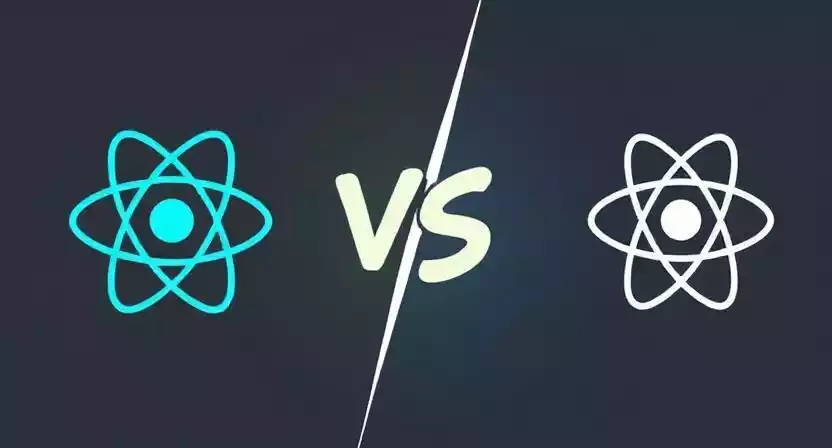In today’s dynamic digital world, building fast, scalable, and user-friendly applications is crucial. Two powerful tools that dominate the front-end development landscape are React and React Native. While they share similar names and are both developed by Facebook, they serve distinct purposes and target different platforms.
Let’s dive deep into what makes React and React Native unique, how they compare, and when to use which.
? What is React?
React, also known as React.js or ReactJS, is an open-source JavaScript library used for building user interfaces, primarily for web applications.
? Core Features of React:
- Component-Based Architecture: Breaks UI into reusable components.
- Virtual DOM: Boosts performance by minimizing direct DOM manipulation.
- Declarative UI: Developers describe what the UI should look like, and React updates it automatically.
- Unidirectional Data Flow: Easier to track data changes.
? Use Cases:
- Web applications (SPA, PWA)
- Dashboards and admin panels
- Dynamic websites with complex UI interactions
- E-commerce platforms and CRMs
? What is React Native?
React Native is a framework built on top of React that enables developers to build mobile applications for iOS and Android using JavaScript.
? Core Features of React Native:
- Native Components: Bridges JavaScript with native APIs (Objective-C, Swift, Java).
- Cross-Platform Development: Write once, use on both iOS and Android.
- Hot Reloading: Live preview of code changes during development.
- Rich Ecosystem: Access to native modules and third-party libraries.
? Use Cases:
- Mobile apps for startups and enterprises
- MVPs with limited development resources
- Cross-platform social, travel, or eCommerce apps
- Apps requiring faster development cycles
⚖️ React vs React Native: Key Differences
| Feature | React | React Native |
|---|---|---|
| Platform | Web | Mobile (iOS & Android) |
| Rendering | HTML & CSS | Native components |
| Styling | CSS, Sass, CSS-in-JS | StyleSheet API (similar to CSS) |
| Navigation | React Router | React Navigation |
| Performance | Depends on the browser | Near-native performance |
| Code Reusability | Component reusability within web | Code reuse across mobile platforms |
| Learning Curve | Easier for web developers | Slightly steeper if new to native mobile |
?️ Architecture and Underlying Technologies
React:
- Uses the Virtual DOM for efficient UI rendering.
- Combines JSX (JavaScript XML) with component lifecycle methods.
- Relies heavily on tools like Webpack, Babel, and Redux for state management.
React Native:
- Uses native APIs and components like
<View>,<Text>, and<Image>. - Bridges JavaScript with native code using JavaScriptCore (iOS) and Hermes (Android).
- Navigation, animations, and state management can rely on libraries like React Navigation, Reanimated, and Redux or MobX.
? Performance Comparison
React apps are limited by browser capabilities and DOM rendering, which can be a bottleneck for high-performance web apps. On the other hand, React Native bridges the gap between JavaScript and native code, providing near-native performance for mobile apps.
That said:
- React is better for high-performance web UIs.
- React Native is optimized for mobile user experiences but might require native modules for complex functionalities.
✅ Pros and Cons
React Pros:
- Mature ecosystem and large community
- Great developer tools
- SEO-friendly with server-side rendering (Next.js)
- Reusable components
React Cons:
- SEO challenges with SPAs (without SSR)
- Performance depends on browser and DOM
React Native Pros:
- Single codebase for iOS and Android
- Native-like performance
- Faster go-to-market time
- Strong community and growing ecosystem
React Native Cons:
- Complex apps might still need native code
- Slower updates for platform-specific features
- Debugging can be tricky due to bridging
? When to Use What?
| Scenario | Use React | Use React Native |
|---|---|---|
| Building a responsive website | ✅ | ❌ |
| Creating a mobile app for iOS and Android | ❌ | ✅ |
| Developing a progressive web app (PWA) | ✅ | ❌ |
| Quick MVP for mobile platforms | ❌ | ✅ |
| Need for advanced browser-based UI | ✅ | ❌ |
? The Future of React and React Native
Both React and React Native continue to evolve rapidly.
- React: With innovations like Server Components, React Suspense, and tighter integration with tools like Next.js, the future of web development is dynamic, fast, and modular.
- React Native: With initiatives like Expo, Fabric renderer, and Hermes engine, mobile development is becoming faster and more efficient than ever.
? Final Thoughts
React and React Native are two sides of the same coin. While React is perfect for dynamic, high-performance web applications, React Native brings the same developer experience to mobile platforms with the power of native components.
Choosing between them depends on your project goals, target platform, and development expertise. But one thing is clear — both React and React Native are here to stay, revolutionizing front-end and mobile development for years to come.



